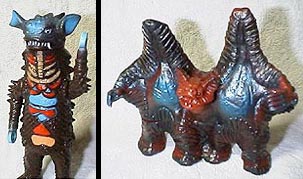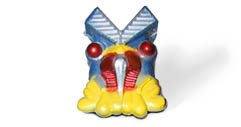![[Alen Yen's ToyboxDX]](images/smlogo.gif)
![]()
![]()
![[Eau de Alt]](libalt/eaumast.gif)

The following is a translated excerpt from the recently published biography of toy-business luminary Saburo Ishizuki, My Work at Marusan and Bullmark. Until the book's publication earlier this year, it wasn't widely known that Mr. Ishizuki was instrumental in founding the company known as Ark as well. My Work provided the first insight into the behind-the-scenes workings of this legendary toy firm.
Ark wasn't around for very long, and they're generally only given credit for two things: a handful of obscure vinyl toys, and a series of "Arklon" diecast monsters (read more about this spectacular series of metal monstrosities in ToyboxDX's Ark Datafile.) This article shows, however, that Ark actually produced quite a bit more than is widely remembered -- and managed to make Ishizuki a wealthy man in the process.
Unfortunately, the excerpt is fairly indicative of the overall tone of the book, which gives diecast toys short shrift in favor of vinyl monsters and plastic models. Still, it's a somewhat interesting read for die-hard aficionados. Enjoy!

![]() THE THIRD COMPANY : ARK
THE THIRD COMPANY : ARK
By Takashi Kuraji
Translation by Matt Alt
In 1978, the year after Bullmark ceased operations, Saburo Ishizuki founded a new company by the name of Ark. The children raised on the kaiju toys made by Marusan in the midst of the first "Kaiju boom" had reached adulthood, and they had begun to indulge their passion for these kaiju by writing about them. These publications garnered interest among fellow adults of the same generation. Before long, the trend spread to children through Popy's introduction of the "King Zaurus" series, calling forth a third "Kaiju boom." Further increasing the groundswell of enthusiasm was the decision to produce the 1980 television series "Ultraman 80." Saburo wanted to produce new kaiju toys as well, but Popy held the rights to make soft-vinyl figures of characters from the Ultraman series and weren't about to let them go. However, Saburo, determined to manufacture kaiju toys, obtained the rights to the shows "Silver Kamen Giant" and "Iron King," produced standard-sized kaiju vinyl from new molds, and sold a series of six types altogether. And when he also sold small-sized soft-vinyl figures (the size of previous eraser-type kaiju toys) from the Drifters' TBS program "Fly!," he was able to achieve sales of some 2,000,000 units.

King Zaurus Toys
Saburo figured that he wouldn't be able to score a major hit with kaiju figures of this size, however. The result of this was the decision to mold kaiju from the Ultraman series in a new material (with embedded magnets), develop a paint that wouldn't rub off easily, and sell the toys as the "Magnet Fighter" series. These were sold in two formats: in sets, and individually via vending machines. These became a huge hit, selling 30,000,000 units altogether. Also, an Ultraman Taro "Jumbo Tama" set reached sales of 2,000,000 units when sold through Seven-Eleven stores. This feat should be admired for broadening the market for toy sales through convenience stores. Saburo had managed to pull off a second comeback in the toy industry.
After this, Ark cooperated with the company Orange to sell six varieties of standard-sized soft vinyl kaiju from the "Zone Fighter" series. Children's' awareness of these characters was low without the benefit of a re-broadcast of the Zone Fighter, Silver Kamen, or Iron King shows upon which they were based. The generation of children who had enjoyed the shows when originally broadcast supported the toys, however, and the figures sold better than anyone had predicted. In addition, in response to a request from Tsubaraya Enterprises, Ark re-released several fondly-remembered Marusan/Bullmark vinyl toys, such as Neronga, Gabora, and kaiju from the Mirrorman series. It was pleasantly nostalgic work for Saburo. However, these soft-vinyl kaiju suffered a rapid drop-off in sales that seemed to be in an inverse proportion to the growing interest in Popy's King Zaurus series.
Saburo also combined the concepts of the Zinclon, Gallock, and Mechablock Series of toys that Bullmark produced near the end of their existence, creating a totally new diecast series called "Arklon." King Joe, Mecha Baltan Seijin, Mecha Black King, Mecha Red King, King Kong, and Mecha Gomora were sold in this series. The body parts of each character were mutually interchangeable, and the ability to make different combinations was the charm of the series. The series attracted attention for creating a completely new style of playing with kaiju toys, and became largely popular both within Japan and as exports. Riding the success of his new enterprise, Saburo settled into a long-awaited life of comfort.
